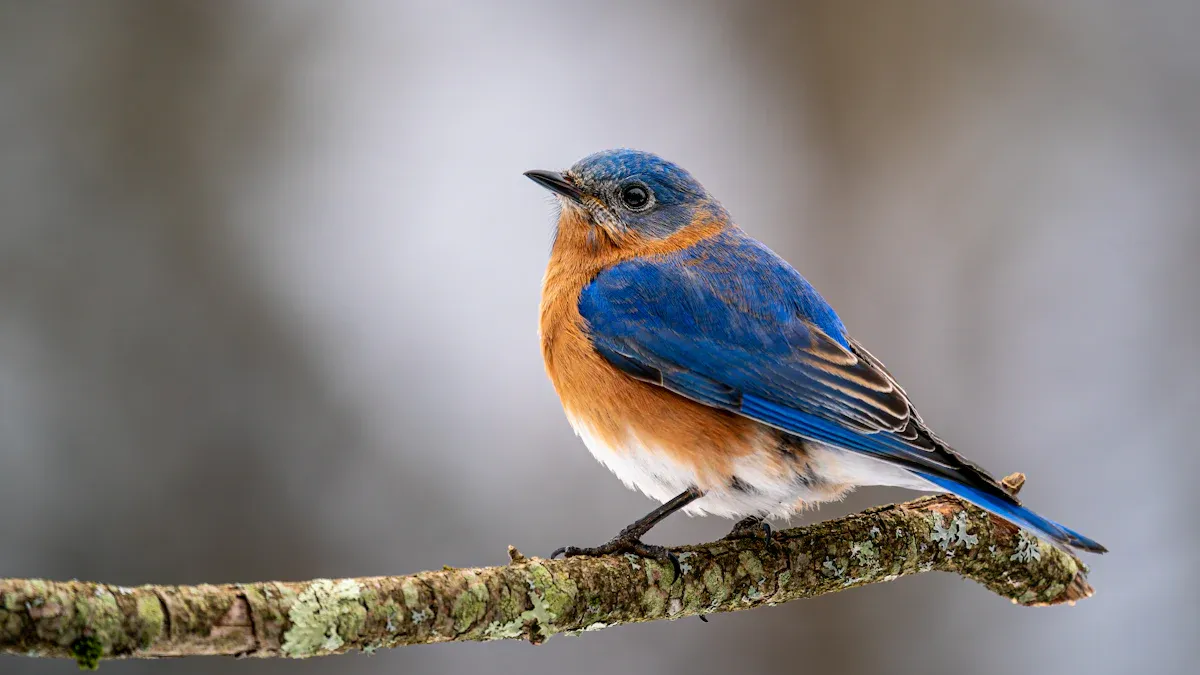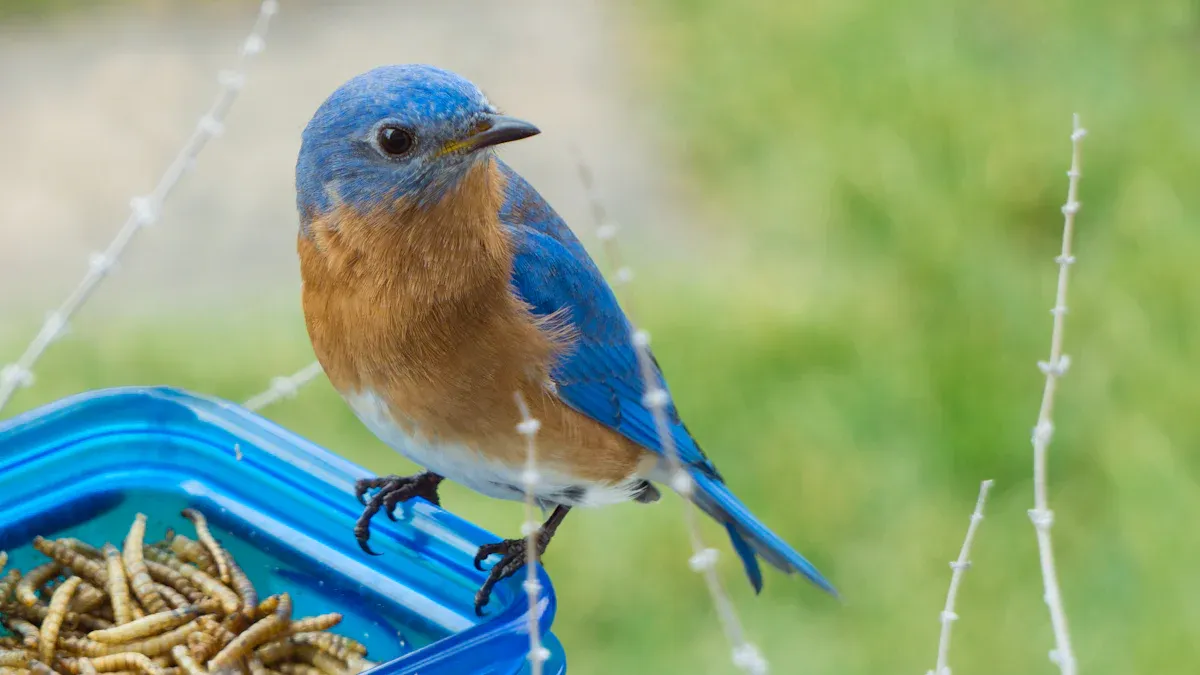
Bluebirds thrive when they have access to nutritious food, especially during challenging times. Dried mealworms bluebirds love provide essential nutrients that support their health and survival. These protein-packed treats are easy to offer and appeal to their natural instincts. A study in Minnesota revealed that bluebirds fed dried mealworms had stronger immune responses to parasites, proving their value during breeding and colder months.
Key Takeaways
- Dried mealworms are healthy for bluebirds. They give protein and fats, which help with energy, growth, and breeding.
- Feeding dried mealworms is easy and saves money. They take up less space and stay fresh longer than live ones, making them simple for bird lovers.
- To bring bluebirds, use the right feeder in sunny, open spots. Watch how much you feed them, and soak mealworms in water to make them tastier.
Nutritional Benefits of Dried Mealworms Bluebirds

Protein for Energy and Growth
Bluebirds are incredibly active birds. They spend their days flying, foraging, and caring for their young. To keep up with this lifestyle, they need a diet rich in protein. Dried mealworms are an excellent source, containing about 50% to 55% crude protein. This high protein content helps bluebirds replenish their energy levels and supports muscle growth. During the breeding season, protein becomes even more critical as it aids in the development of chicks. Offering dried mealworms ensures bluebirds have the energy they need to thrive.
Fats for Breeding and Survival
Fats are another essential nutrient for bluebirds, especially during colder months. Dried mealworms contain a minimum of 24% to 25% crude fat, making them a reliable energy reserve. These fats help bluebirds maintain their body heat and survive harsh weather. During the breeding season, fats also play a role in supporting reproductive health. By including dried mealworms in their diet, you provide bluebirds with the fuel they need to stay strong and healthy year-round.
Fiber and Nutrients for Digestive Health
In addition to protein and fats, dried mealworms offer fiber and other nutrients that promote digestive health. They contain 6% to 9% crude fiber, which helps bluebirds process their food efficiently. The table below highlights the nutritional composition of dried mealworms:
| Nutrient | Amount |
|---|---|
| Crude Protein | 50% – 55% |
| Crude Fat | 24-25% (min.) |
| Crude Fiber | 6-9% (min.) |
| Moisture | 4-6% |
This balanced nutrition makes dried mealworms a perfect addition to a bluebird’s diet. They not only support digestion but also provide essential micronutrients that contribute to overall health.
Why Choose Dried Mealworms Over Live Mealworms
Convenience and Easy Storage
Dried mealworms are a game-changer for backyard birders. They’re incredibly easy to store and handle compared to live mealworms. You can keep them in gallon-sized sealing bags, which take up minimal space. On the other hand, live mealworms require a small container, usually 16-24 ounces, and need more attention to maintain their living conditions.
| Aspect | Dried Mealworms | Live Mealworms |
|---|---|---|
| Storage Space | Stored in gallon-sized sealing bags | Requires a small 16-24 ounce container |
| Handling Convenience | Simply pour into a dish, no handling | Requires more handling due to live nature |
With dried mealworms, there’s no need to deal with crawling insects. Just pour them into a dish or feeder, and you’re good to go. This simplicity makes them a favorite among bird enthusiasts who want to enjoy feeding birds without the hassle.
Cost-Effectiveness and Longevity
Dried mealworms offer excellent value for money. They last much longer than live mealworms, which can spoil or die if not stored properly. A single bag of dried mealworms can feed bluebirds for weeks, making them a cost-effective choice. Their extended shelf life also means fewer trips to the store, saving both time and effort. For anyone looking to attract bluebirds without breaking the bank, dried mealworms are a smart investment.
Low Maintenance and Reduced Mess
Feeding dried mealworms is a low-maintenance activity. Unlike live mealworms, they don’t require refrigeration or special care. There’s no need to clean up after them, as they don’t leave behind bedding or waste. This makes them a cleaner option for both you and the birds. Plus, dried mealworms bluebirds love are less likely to attract unwanted pests, keeping your feeding area tidy and enjoyable.
Best Practices for Feeding Dried Mealworms to Bluebirds
Selecting the Right Feeder
Choosing the right feeder can make a big difference in attracting bluebirds. Feeders designed specifically for bluebirds often include features that exclude larger birds like starlings and jays. A good feeder should also have a roof to keep mealworms dry and protect them from rain or intense sunlight. Durability is key—materials that resist rust and wear ensure the feeder lasts for years. Additionally, feeders with openings at least 1.5 inches wide allow bluebirds easy access while keeping things simple for you. Look for feeders with removable trays, as they make cleaning and refilling a breeze.
| Criteria | Description |
|---|---|
| Excludes larger birds | Prevents access by starlings and jays. |
| Sheds rain | Keeps mealworms dry and fresh. |
| Durability | Made from long-lasting, rust-resistant materials. |
| Easy access for bluebirds | Openings large enough for bluebirds to enter comfortably. |
| Easy to fill and clean | Includes removable trays for convenience. |
| Versatile use | Can also hold other foods like suet or berries. |
Placement Tips for Attracting Bluebirds
Where you place the feeder matters just as much as the feeder itself. Bluebirds prefer sunny spots with open spaces nearby, such as the edge of a large, well-maintained lawn. Avoid placing feeders in deep shade or near windows to reduce the risk of bird collisions. Keeping the area free of pesticides also encourages bluebirds to visit. Research shows that feeders in these ideal locations can improve nesting success and fledgling health, making your backyard a haven for these beautiful birds.
Portion Control and Feeding Frequency
Moderation is essential when feeding dried mealworms to bluebirds. While mealworms are nutritious, offering too many can lead to dehydration or digestive issues, especially for young birds. A small handful of mealworms once or twice a day is usually enough. During nesting season, slightly increasing the portion can help support the energy needs of parent birds and their chicks. Always monitor how much the birds consume to avoid overfeeding.
Rehydrating Mealworms for Added Appeal
Bluebirds naturally prefer live mealworms, but rehydrating dried ones can make them more enticing. Soaking dried mealworms in warm water for 10-15 minutes softens them and adds moisture, making them easier to digest. This is especially helpful for nestlings, as hydration is crucial for their development. Many bird enthusiasts find that rehydrated mealworms attract bluebirds more effectively, giving them a nutritious and appealing treat.
Feeding dried mealworms is an easy way to help bluebirds thrive. These nutritious treats keep them healthy and active. Plus, watching bluebirds visit your yard creates a special connection to nature.
Supporting bluebirds doesn’t just benefit them—it also contributes to conserving local bird populations for future generations. 🐦
FAQ
How do I store dried mealworms?
Keep dried mealworms in a cool, dry place. Use an airtight container to maintain freshness and prevent moisture. Proper storage ensures they last longer and stay appealing to bluebirds.
Can I mix dried mealworms with other bird food?
Yes! Combine dried mealworms with seeds or suet for a balanced mix. This attracts a variety of birds while providing bluebirds with the nutrients they need.
Tip: Mixing mealworms with berries can make the feeder even more irresistible to bluebirds! 🍓🐦
How often should I feed bluebirds dried mealworms?
Offer mealworms once or twice daily. Adjust portions based on how much they eat. During nesting season, slightly increase the amount to support parent birds and chicks.


